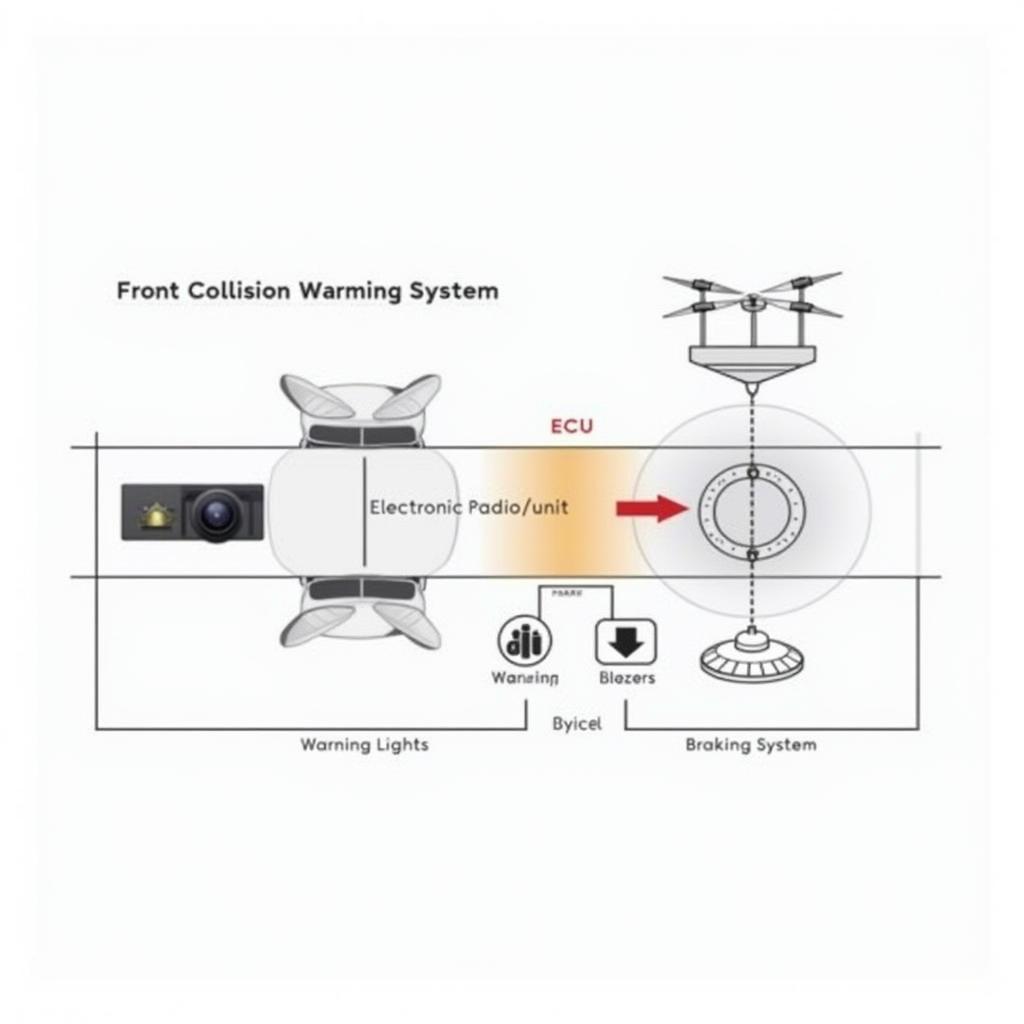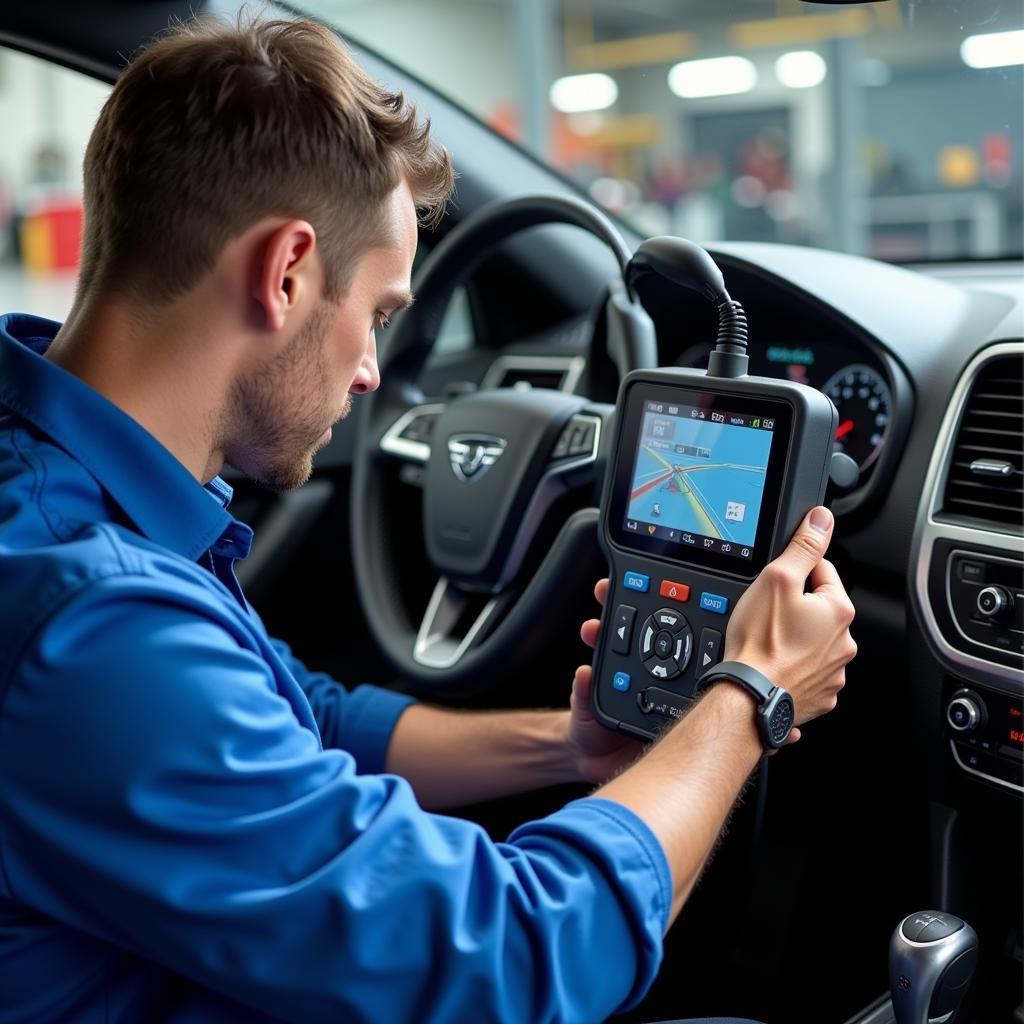The forward collision warning with brake support system is an advanced safety feature designed to help prevent or mitigate frontal collisions. It uses sensors, typically cameras and/or radar, to monitor the distance and closing speed to the vehicle ahead. When the system detects an imminent collision, it warns the driver and can even automatically apply the brakes to avoid or lessen the severity of the impact. But what does it mean when you encounter issues with this crucial safety system?
This comprehensive guide delves into the intricacies of the forward collision warning with brake support system, addressing common problems, troubleshooting tips, and expert insights to keep you safe on the road.
Understanding Your Car’s Safety Net
Before we dive into troubleshooting, it’s crucial to understand how this system operates. The forward collision warning system acts as your car’s second set of eyes, constantly scanning the road ahead. Here’s a simplified breakdown:
-
Sensing: Utilizing advanced technology like radar or cameras, the system continuously measures the distance and closing speed to the vehicle in front of you.
-
Analyzing: The system’s computer processes this data, comparing it to predetermined safety parameters and your vehicle’s speed.
-
Alerting: If a potential collision is detected, the system issues visual and audible warnings, giving you precious time to react. These warnings might include flashing lights on the dashboard, beeping sounds, or even a vibrating steering wheel.
-
Braking: In critical situations, where the system deems a collision unavoidable, the brake support function automatically applies the brakes. This intervention is designed to minimize the impact or, ideally, prevent the accident altogether.
 Forward Collision Warning System Components
Forward Collision Warning System Components
Common Issues and Troubleshooting Tips
While advanced driver-assistance systems like forward collision warning with brake support are rigorously tested, issues can still arise. Here are some common problems and practical solutions:
1. System Malfunction Warnings
Seeing a warning light or message related to your forward collision warning system can be alarming. Here’s what to do:
- Check Your Surroundings: Ensure there are no obstacles too close to your vehicle, as this can trigger false alarms.
- Clean the Sensors: Dirt, snow, or ice build-up on the sensors can obstruct their functionality. Gently clean them with a soft cloth.
- Restart Your Vehicle: Sometimes, a simple system reboot can resolve temporary glitches. Turn off your car, wait a few minutes, and restart it.
Expert Insight: “Many drivers overlook the importance of regular sensor maintenance. Just like you wouldn’t drive with a dirty windshield, ensuring your car’s sensors are clean is essential for optimal system performance.” – John Smith, Senior Automotive Diagnostic Technician
2. Intermittent or Inconsistent Warnings
Experiencing random or inconsistent warnings from your system can be frustrating and potentially dangerous. Here’s what to investigate:
- Software Updates: Outdated software can cause compatibility issues. Check with your dealership or manufacturer for available updates.
- Electrical Issues: Loose wiring or a failing sensor can disrupt the system’s signals. It’s best to consult a qualified mechanic for diagnosis and repair.
- Driving Conditions: Extreme weather conditions, like heavy rain or fog, can affect the system’s accuracy. Be extra cautious in such situations.
Expert Insight: “If you’re encountering intermittent warnings, it’s crucial not to ignore them. These inconsistencies often point to an underlying issue that requires professional attention.” – Jane Doe, Certified Automotive Electronics Specialist
3. Brake Support System Not Engaging
If the brake support doesn’t engage when you anticipate it should, consider these factors:
- System Limitations: Remember, the brake support system is designed as a last resort. It might not engage in every situation, especially if you have sufficient time and distance to react.
- Brake System Health: A problem with your car’s regular braking system, like worn-out brake pads, can impact the brake support’s functionality.
- Calibration Issues: If the system was recently serviced or components were replaced, it might require recalibration by a qualified technician.
smart brake support15 with collision warning
Expert Insight: “Never rely solely on the brake support system. It’s a safety net, not a substitute for attentive driving and proper braking techniques.” – David Wilson, Automotive Safety Systems Engineer
4. False Warnings
While designed to be highly accurate, false alarms can occur. Here’s how to minimize them:
- Adjust Sensitivity: Most systems allow for sensitivity adjustments. If you’re experiencing frequent false alarms, consider lowering the sensitivity level.
- Driving Style: Aggressive driving, like tailgating, can trigger more frequent warnings. Maintain a safe following distance.
- Road Conditions: Steep hills, sharp curves, or uneven surfaces can sometimes confuse the system’s sensors.
mazda 3 smart city brake support warning light
Expert Insight: “Remember, even the most advanced safety features are not foolproof. Always stay alert and be prepared to take control of your vehicle.” – Sarah Jones, Automotive Technology Instructor
 Mechanic Inspecting Car Sensors
Mechanic Inspecting Car Sensors
Forward Collision Warning with Brake Support: A Vital Safety Feature
The forward collision warning with brake support system is a critical safety feature that can significantly reduce the risk of accidents. By understanding its operation, common issues, and troubleshooting tips, you can ensure this system functions optimally, providing you with an extra layer of protection on the road.
Remember, if you encounter persistent problems or are unsure about any aspect of your car’s safety systems, it’s always best to consult a qualified mechanic or your dealership for expert diagnosis and repair.
FAQ:
1. Can I turn off the forward collision warning with brake support system?
Yes, most systems allow you to temporarily disable the feature through your vehicle’s infotainment system. However, it’s generally recommended to keep it activated for enhanced safety.
2. Will the system still work if my windshield is cracked?
Depending on the location and severity of the crack, it could potentially interfere with the camera’s field of view, affecting the system’s performance. It’s best to get it inspected by a professional.
3. Does the system require regular maintenance?
While there’s no specific maintenance schedule, keeping the sensors clean and ensuring your car’s software is up to date is crucial for optimal performance.
4. Can I install a forward collision warning with brake support system in my older car?
Aftermarket systems are available, but compatibility varies greatly depending on your car’s make, model, and year. Consult with a qualified installer for options.
5. Does the system work at night or in bad weather?
While the system is designed to operate in various conditions, its effectiveness can be reduced in heavy rain, fog, snow, or when visibility is compromised.

